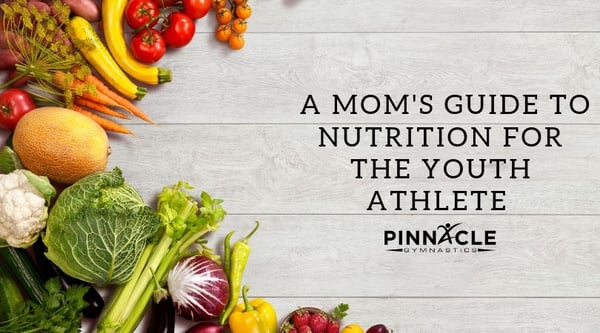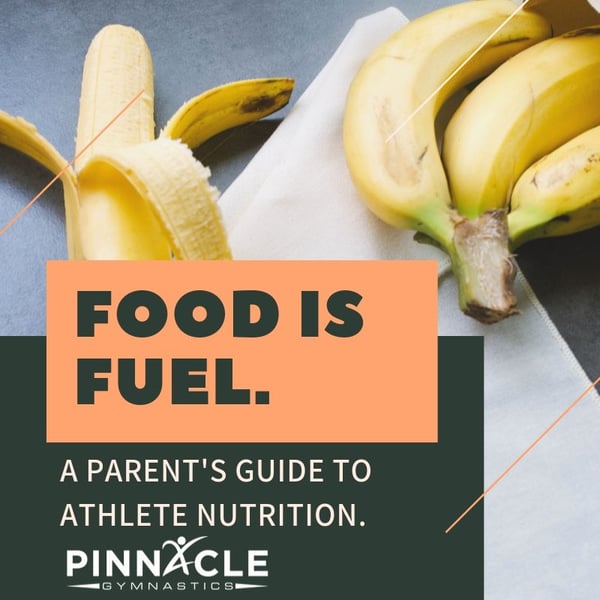Let’s cover some basics first. Athletes are NOT normal people. They need MORE calories than a person the same age who goes to school and then home to play video games. Video games use up time; not calories!
Calories are made up of carbohydrates, protein, and fat. Everybody needs fat; even athletes. The percentage of each is a debate. People that like the “Zone” or “Atkins” believe you should have more protein while other diets suggest more carbs. There is probably no one correct answer and every expert has a reason why theirs is best.

- Protein is used for building blocks for new growth as well as making enzymes, immune system use, and other long term health needs.
- Fat is used as a secondary energy when carbohydrates are running low. It is also an important resource for the brain, connective tissues, and for storing fat soluble vitamins.
- Carbohydrates are used for fast energy and are probably most important during the actual activity. Carbs are stored as glycogen to be used during the first 90 minutes of exercise. After that, fat is needed for further energy if carbs are not replenished.
For conversation sake, many sports nutritionists would recommend 50-65% carbohydrates, 15-25% protein, and 25-35% fats. If your expert says something different, that is ok… keep reading anyway!
Before Practice Snacks
Before practice, an athlete should prepare for workout. Carbohydrates are the food stuffs that are broken down the quickest. An apple, fruit juice, or bagel would be examples of easily digested, quickly usable carbs. Peanut butter offers both some carbs and some protein- a great combination to put on a bagel!
Depending on the exercise decides the need for a snack mid way through. Aerobic exercise is constant- such as long distance running, swimming, or the forward on a soccer team. Anaerobic exercise is not constant- such as gymnastics, or the center tackle on the football team. Aerobic exercise uses up energy more quickly. That is why marathon runners are offered orange slices and juice every few miles and anaerobic exercise like football linemen might play an entire game only needing water or a sports drink.

What to Eat (and Not to Eat) Immediately After the Workout
After a workout, the body is craving carbohydrates from the depletion during exercise. If you are going to have something not healthy this would be the time. The snack should not be excessive though- not for about thirty to sixty minutes.
During exercise, blood goes to the area that is hungry for oxygen. You will notice your biceps fill with blood during curls while weight lifting. Where is this increased blood flow from? Well, during exercise, the brain, kidneys, and heart keep their needed blood flow and the muscles in need “steals” the blood from less vital organs such as the stomach and intestines. During this time, the stomach and intestines receive less blood so the muscles and heart (coronary blood vessels) can get more. It takes time after exercise for the blood flow to regulate itself back to normal. Cramps, stomach aches, and even nausea may result from a large meal immediately after exercise since the stomach and intestines are unprepared to work.
How About Dinner After Competition?
This is a good time for protein- those building blocks for future growth of muscle, bone, and needs of metabolism. Athletes need carbohydrates right before, during, and right after exercise and then protein for the days after. Meals not directly around exercise are a good time for protein and fat.
So What About Fat?
It is actually important too- it is used for reserve energy if carbohydrates are used up. The brain is made of mostly water and fat. Fat is also used to break down and store fat soluble vitamins.
Here is an example of the fewest calories needed for a premier level male soccer player who weighs 100 pounds.
A: 100 pounds divided by 2.2 = 45 kilograms
- 45 kg times 24 hours = 1080 calories needed for daily basal rate
- 1080 times 2 for heavy exercise = 2160 total calories needed to play soccer at a high level
Therefore, this athlete needs 1080 calories for daily living and ANOTHER 1080 calories to play soccer to ensure that growth is normal, and the chance of injury is reduced
Fewest Acceptable Total daily calories = 2160 calories
More calories are not bad, especially if weight gain is a goal. The other calculation takes weight gain into account.
B: 100 pounds X 25 calories per pound per day= 2500 calories needed per day
The results: A growing athlete weighing 100 pounds therefore, (during puberty) that does not get between 2100-2500 calories a day risks shorter than normal growth potential, a higher risk of stress fracture and muscle injury, a hungry and easily distracted mind, and a less than full potential athlete.
It’s like a race car with 87 octane fuel which knocks and sputters… it would run better, smoother, and faster with 100 octane fuel!
Athletes Have Different Nutrition Needs
The constant media attention on eating right, fad diets, and not eating so much is directed towards the non-athlete. And while the American public indeed has a greater percentage of unhealthy, obese people at risk for diabetes II, hypertension, and high cholesterol - the great majority of young athletes need healthy calories for continued growth and muscle/bone strength. The media also promotes tiny, fatless models that may mislead young athletes in believing the less you weigh the better. On the contrary, calories help athletes achieve stronger bones and increased muscle- all which must weigh something!
Lastly, eating shouldn’t be worrisome or complicated for the young athlete- good habits started while young can last a lifetime (as can the bad habits). Eating should be fun and taste good and offer the right combination of nutrients, calories, and vitamins/minerals.
Happy eating!
Board Certified Pediatrician with an interest in Sports Medicine
Concussion Management Team
Team Medicine




